Acrylic paint is made specifically to be used on canvas, plastic, fabric, metal, and other such surfaces. It works well on almost every surface, but when it comes to using it over the skin, the situation is different.
Skin is a living tissue and is very sensitive to foreign agents (including pigments). It keeps changing its consistency and texture but is not always notable to the naked eye, which is why using acrylic paint on skin is not always recommended.
However, there are ways to make the paint safe for the skin and avoid side effects which will be discussed in the post. Moreover, I’ll elaborate complete procedure to paint a face with acrylic and answer all the queries clicking in your brain.
| Can Acrylic Paint Be Used On the Skin? Yes, you can use acrylic paint on your skin as long as you’re following the basic healthcare protocols, using a non-toxic brand, and using the dye along with skin primer, moisturizer, and lotion. |
Is Acrylic Paint Safe For Skin?
Well, if you look from the medical point of view, the paint is not suitable for the skin and can lead to several complications. But it doesn’t mean it is deadly or fatal, you can use it as an alternative to face paint.
However, if we talk about the potential hazards, acrylic paint can cause the following side effects if used the wrong way.
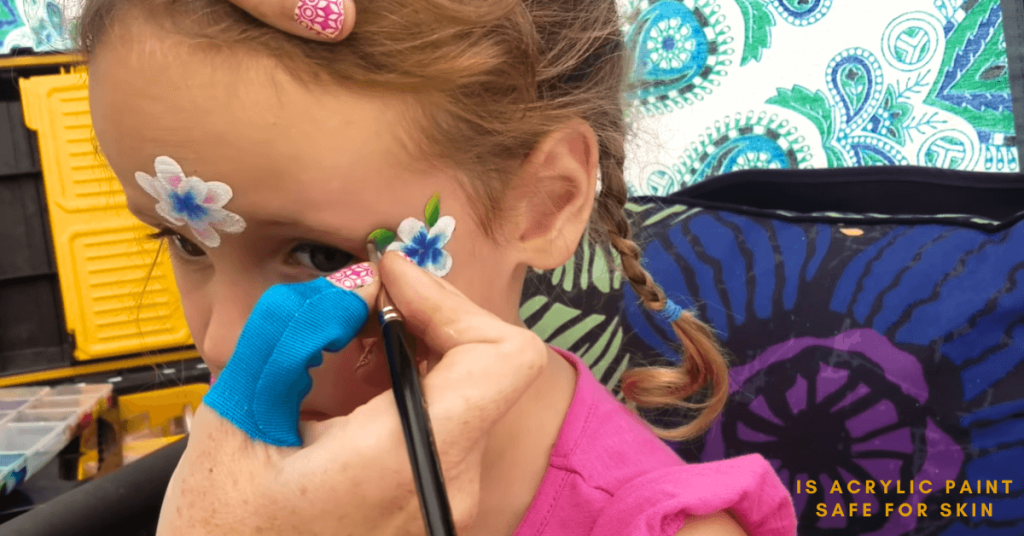
- Allergic Reaction
Our body shows resistance to foreign agents. So whenever you apply acrylic paint on face, there is a possibility your body may show responsive reactions, which can irritate your skin. So you must check the paint for sensitivity and allergy (Discussed later) before applying.
- Swelling
Acrylic paint can cause swelling if applied to the section which is wounded. So make sure your skin is smooth and healthy. Moreover, toxic paint types can damage the skin and cause wounds. These wounds may lead to swelling and, ultimately, severe health concerns. So be careful while choosing paint for your skin. It must be non-toxic.
- Itching And Redness
Acrylic paint causes itching and redness if applied to the skin uncontrolled. The reason is against your immune system circulating blood to the painted area of the skin. So, make sure you use a face primer, lotion, or moisturizer (Discussed later).
- Skin Diseases
The paint can sometimes lead to skin diseases like dermatophytosis and bacterial skin colonization. It is due to the weak immunity and toxicity of the paints, which pave the way for microbes to enter deep into the skin or settle on the top. Again, use a non-toxic dye having no hazardous ingredients and use a face primer.
How To Check If Acrylic Is Safe For Your Skin?
Suppose you’ve decided to apply acrylic paint to your face and hands and bought a non-toxic brand as well. Is it enough? Should you go and start painting your skin? No, not! The best practice is to check if your skin is sensitive to the paint or not, especially when you are using acrylic paint for tattooing, because every individual has a distinct immune response and skin type. You can trial the paint in the following way.
- Take a small quantity of the paint and apply it to a small part of your hand.
- Wait for a few minutes.
- If you notice redness or feel itchy, the paint is not probably for you.
- If no signs of allergic reactions are shown, go for it.

How To Make Acrylic Paint Safe For Skin? 4 Things To Consider
Now let’s talk about how we can make acrylic paint skin friendly and use it without side effects. Let me clear one thing your immunity and skin type are significant deciding factors if the paint is safe for your face or not. No matter what type of skin you have, here is how to turn acrylic paint into face paint.
- Choose Non-Toxic Brand
The uttermost thing is choosing a brand of acrylic paint that is pure water-based and lacks additional substances which are dangerous to the skin and can cause toxicity. Well, for that, you have to read the label to see if it says non-toxic or not.
Moreover, check out the composition of the paint mentioned on the packing and make sure there is no harmful element. You can take the help of Google or take an advice of a Chemist too.
- Use Face Primer
Can you put acrylic paint on your face? Yes, you can, but a face primer should be used before painting the face or hands. Natural primers like aloe vera, algae extracts, or synthetic primers containing amino acids are good in this case. They will create a safe barrier between the skin cells and the paint molecules.
- Use Lotion
Using a lotion is also good for the skin when you’re going for acrylic as face paint. Lotion protects the paint from contacting the skin cells directly. Moreover, due to the moisturising properties of lotion, the skin remains hydrated, which can prevent itching due to dryness.
- Apply Thin Coats
Applying the paint in thin coats minimises many risks. Thin coating means less paint which can reduce the probability of side effects. Moreover, thin painting prevents you from tight skin, which you feel after the paint is dried on your face.
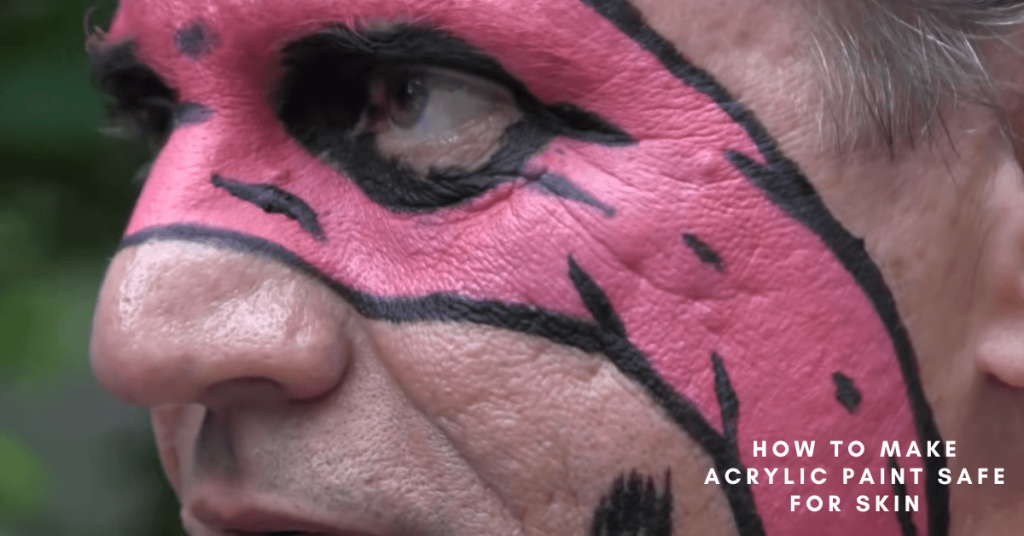
How To Apply Acrylic Paint On Skin (Face And Hands)?
Painting the face and hands with acrylic paint is simple and easy. But easy things are the most difficult sometimes. No worries, I’m here to guide you on how to paint the skin with acrylic paint. Kindly read the instructions below.
Supplies Needed
- Face Primer
- Acrylic paints (Non-Toxic)
- Cotton pieces
- Paint brushes
- Lotion
- Paint thinner
- Face wash
Procedure To Paint Skin
Step 1: Clean Your Skin
The very first thing is to wash your face and hands. Use face wash and warm water to clean your face. Take a sterile towel and wipe your face. Clean skin helps the primer and paint stick better. Moreover, cleaning the skin helps reduce the chances of allergic reactions.
Step 2: Prime Your Skin
The next step is priming your skin. Take a small amount of face primer on your fingertips and apply it over the face. Cover your skin thoroughly and evenly. Primer will help the paint stick and protect your skin cells from direct contact with the dye. You can use a make-up primer or lotion for this purpose.
Step 3: Thin Down The Paint
Now take acrylic paint in a bowl, add paint thinner and stir well. It will dilute the paint and help you apply it over the skin in thin coats. As I’ve mentioned earlier in the post, you should use thin layers of dye on your face, so this step is crucial.
Step 4: Paint Your Skin
Start painting your skin with a paintbrush. Draw designs with a sharp brush according to your style and use a flat top brush for filling large sections. It all depends on your requirements for painting.
Step 5: Let The Paint Dry
Once you’re done painting your skin, let it dry in the open air. Make sure you don’t talk or move your face or hand muscles, as it can create gaps between the painted sections. In other words, the paint may crack.
| WARNING Don’t let the paint enter your eyes, nose or mouth. It can cause serious health concerns. |
How To Remove Acrylic Paint From Skin?
After the event is over, you might be thinking of removing DIY acrylic face paint from your skin. Acrylic paint is a bit tricky to apply on the skin as it is water-based and dries quickly, but removing it is simple. Here are the ways to wash the dye.
- Soap And Warm Water
Acrylic paint can be removed using soap and warm water. Wet your painted skin, apply soap, massage, and scratch the stains well. Wash with warm water, then. Repeat the process if the paint is not washed off thoroughly.
| CAUTION Don’t forget to apply a soothing lotion after the paint is removed. It relaxes the skin muscles and reduces after-effects. |
- Rubbing Alcohol
Another option to remove acrylic paint from the skin is using rubbing alcohol. Simply take a diluted solution of ethyl alcohol on a cotton piece and start rubbing your skin. The paint will get soft and easy to scrap. Wash the face after that and apply a lotion or moisturiser.
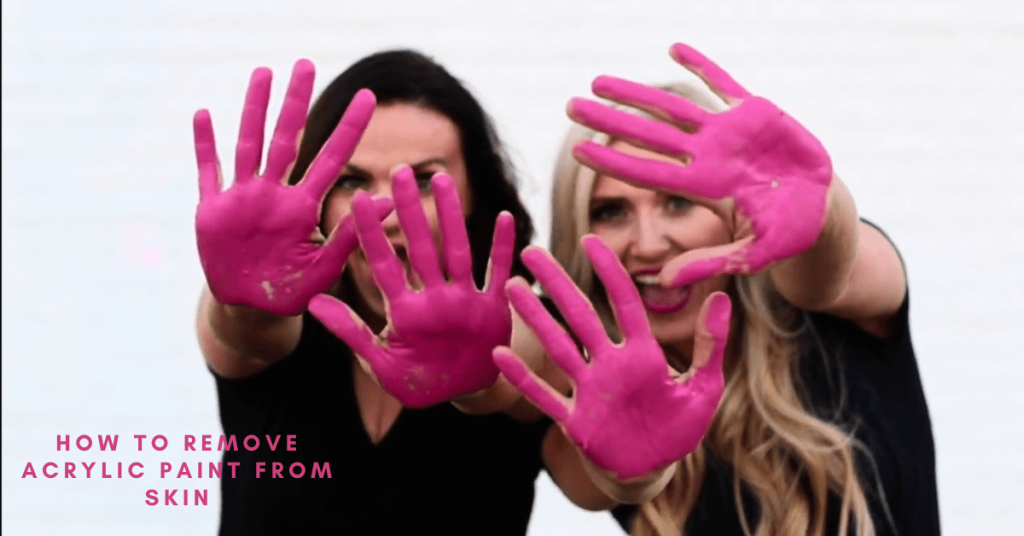
What Paint Is Safe For Skin Other Than Acrylic?
Water-based paints are good and safe to use on the skin as they are non-toxic, but still, you need to confirm if they are skin friendly. Alcohol-based paints are also suitable for the skin because the solvent is not harmful. Here is a list of some skin safe paints to choose for your face.
- Henna Paint
Henna is prepared from plants and consists of natural ingredients. It is the most common cosmetic paint used for designing hands, faces and feet. It comes in powdered and wet (cone) forms. You need to add water and make a suspension. Apply it to the skin and wash it after it gets dry. It leaves a bright and vibrant colour behind.
- Metallic Face Paint
Metallic face paints are common cosmetic paints used for colouring your skin. They give a bright, dark and glitter appearance after application. They are non-toxic and can be used with make-up or paintbrushes. The paint gives a metallic finish.
- Latex Paint
Can you paint latex on your face? Yes, latex paint is a good choice to paint your face. It is mainly used for altering the face design for Halloween. The paint is water-based and sticks to the skin firmly. Thoughtful and sharp designs are a bit difficult with the paint, but it is ideal for textures.
- Tempera Paint
Is tempera paint safe for skin? It is safe to use on the skin as it is water-based and non-toxic. But leaving it on the skin for longer leads to spots and stains on your skin. However, applying it with face primer and washing it right after the event is recommended.
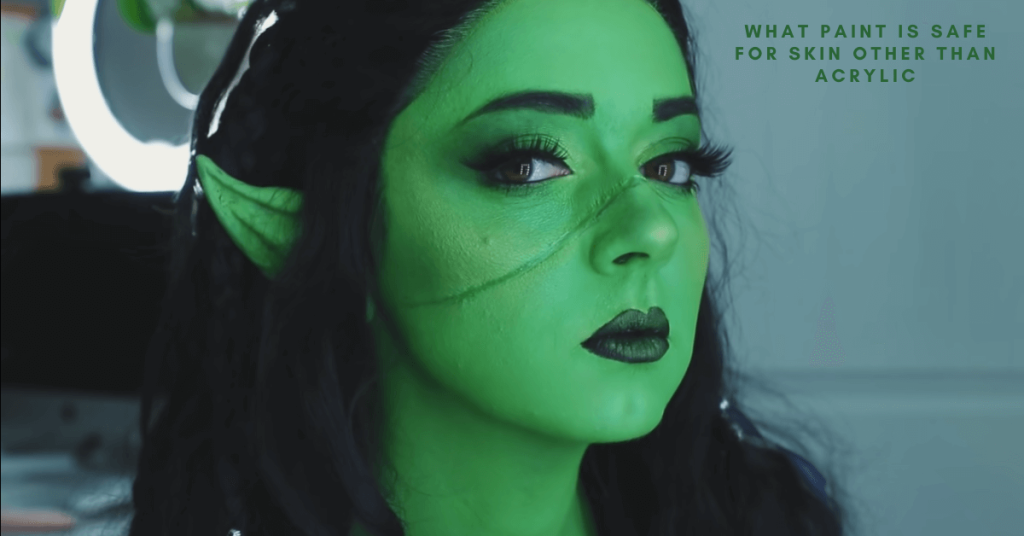
Ideas For Face Painting With Acrylic Paint
So if you’re planning to alter your facial appearance into something unique design for Halloween or want to paint your face to support your team in the coming sports, acrylic is a good choice if used accurately. Here are a few painting ideas for you.
- Animated Designs
You can covert your face into an animated look like a lion, tiger, panda, bird, butterfly, dragon and many more. It requires a little bit of expertise but can be watched tutorials on YouTube as well.
- Super Hero
You can draw a superhero mask like Batman, Spiderman and others on your face. These designs are liked by kids. They are not difficult to draw and can be mastered after a bit of practice.
- Horror Face
Horror designs on faces can be drawn for Halloween. There are a lot of ways to alter your face depending on your skills and creativity. You can go for the following ones.
- Jaws
- Wounds
- Ripped Face
- Stitches
- Blind Eyes
- Vampire
- Nun
- Joker Face
- Animal Mouth and Teeth
- Abstract Art
Face can be altered into abstract art designs. They are pretty tricky and need creative minds and expertise. However, you can try them by blending different colours and applying them over the face at different angles.
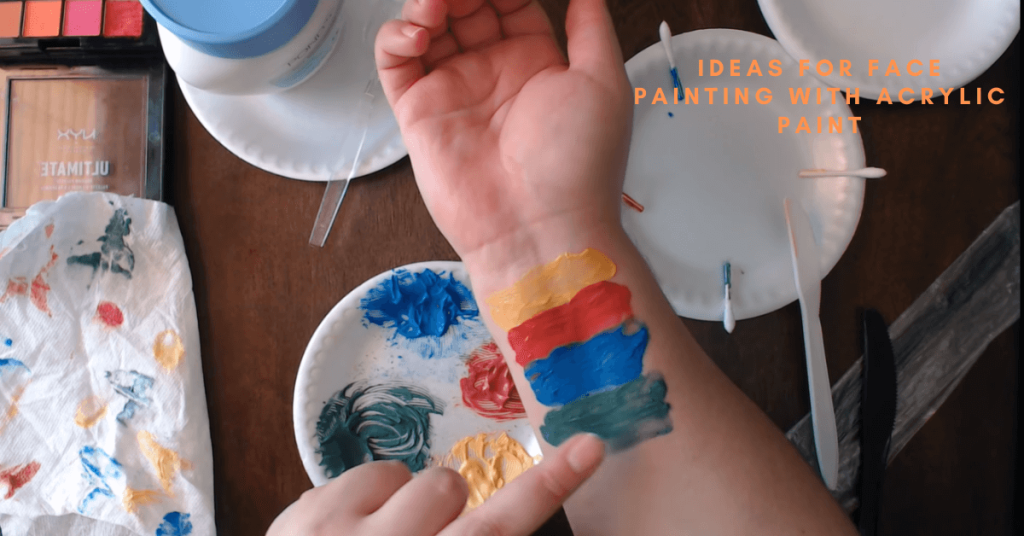
How To Make Face Paint At Home?
If you’re out of budget or want something new for your face painting, you can try homemade face paint. Here is what you’ll need and the procedure.
- You need water, food colour, a bowl, cornstarch, flour, and lotion.
- Mix the above ingredients and stir well.
- Add water according to your choice. More water means thin paint, while low water content means thicker paint.
- Store the paint in a container having a fitting lid.
- You are done.
You can also read: Can you use acrylic paint to dye hair?
FAQs
Is acrylic paint safe for face?
No acrylic paint is not safe for the face. However, if you use it along a base coat or face primer, the risk of health hazards can be reduced
Can you use water-based acrylic paint on skin?
Yes, acrylic paint can be used on the skin as it is based on water. It dries quickly and adheres to the skin strongly. But make sure you’re using a face primer and paint which is non-toxic to the human body.
Can you use acrylic paint for animals?
Generally, Acrylic paint is non-toxic to cats, dogs and other pets or animals, but many factors need to be addressed.
Can you put watercolor paint on your face?
Yes, watercolors can be applied to the skin if you’re not allergic to its ingredients. Apply a small amount of watercolor to your hand and check if your body responds with redness and itching.
What can I mix with acrylic paint for face painting?
You don’t need to mix anything with acrylic for face painting. Instead, apply a face primer as a base coating and thin down the paint by adding a paint thinner to make it ideal for usage on the skin.
What can I use instead of face paint?
You can use water-based colours like acrylic and latex dyes and alcohol-based colours as alternatives to face paint. Moreover, henna paint and metallic paint are excellent and safe options too.
Can you mix acrylic paint with the foundation?
You should not mix acrylic paint with foundation as both are different in composition. Instead, use acrylic paint over a primed face for safe and better results.
Is acrylic paint safe on skin?
Applying acrylic paint directly on the skin is not safe. It can cause itching and allergic reactions if used without precautions.
Final Thoughts
So, can acrylic paint be used on the skin? Well, you can decide better after reading the information I’ve provided. As long as I’m concerned, I’ve used the paint many times for the skin and found it effective and safe. But I’ve never ignored basic health protocols and procedures mentioned in the post.
I hope the post will be proved helpful for you. You can comment with your suggestions and queries below. I’ll get back to you. Thank You!
- How To Buff Acrylic Enamel Paint In 5 Easy Steps? Thorough Guidance - February 2, 2024
- How To Make Acrylic Paint More Opaque? 10 Effective Methods - February 1, 2024
- How To Sketch On Canvas Before Acrylic Painting? Draw Like a Pro - January 31, 2024

